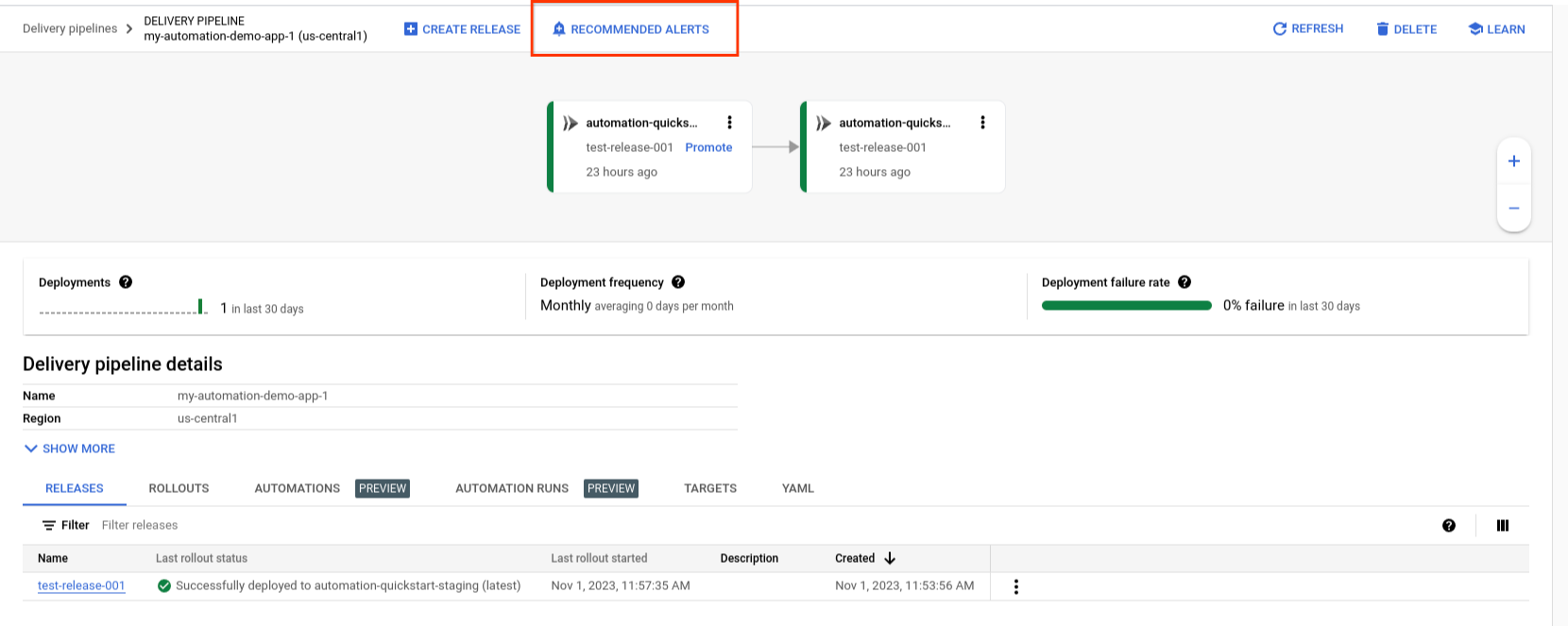Halaman ini menjelaskan cara menggunakan Cloud Deploy dan Google Cloud Observability untuk menyiapkan kebijakan pemberitahuan agar Anda diberi tahu tentang peristiwa dan kondisi tertentu di Cloud Deploy.
Pemberitahuan untuk Cloud Deploy dibuat menggunakan log platform yang disimpan oleh Cloud Logging. Google Cloud Observability mendukung pemberitahuan yang dibuat menggunakan data deret waktu dari Cloud Monitoring, tetapi pemberitahuan Cloud Deploy hanya didasarkan pada log.
Kebijakan pemberitahuan Cloud Deploy berlaku per pipeline pengiriman.
Apa yang dimaksud dengan pemberitahuan?
Notifikasi adalah notifikasi dari Google Cloud Observability dalam kondisi tertentu. Anda menentukan kondisi tersebut dalam kebijakan pemberitahuan. Dokumentasi Google Cloud Observability menjelaskan pemberitahuan dan kebijakan pemberitahuan secara lebih mendetail. Dokumen ini menjelaskan aktivitas Cloud Deploy tertentu yang dapat Anda siapkan kebijakan pemberitahuannya.
Pemberitahuan yang tersedia
Anda dapat menyiapkan kebijakan pemberitahuan untuk situasi berikut, khusus untuk Cloud Deploy:
Operasi render, untuk rilis tertentu, telah gagal.
Untuk setiap rilis, semua manifes, definisi layanan, dan konfigurasi lainnya yang harus dirender, dirender untuk semua target sebelum apa pun di-deploy. Notifikasi ini memberi tahu Anda jika operasi rendering rilis gagal.
Peluncuran gagal.
Notifikasi ini memberi tahu Anda saat peluncuran dalam pipeline pengiriman ini gagal. Kemudian, Anda dapat mengambil tindakan, seperti yang dijelaskan dalam artikel Mengelola peluncuran.
Peluncuran memerlukan persetujuan.
Salah satu target Anda dikonfigurasi untuk memerlukan persetujuan, dan rilis kini dipromosikan ke target tersebut, tetapi persetujuan masih menunggu keputusan.
Peluncuran dengan strategi deployment canary memerlukan kemajuan fase.
Saat menggunakan strategi deployment canary, setiap penambahan canary adalah fase dalam peluncuran untuk rilis dan target tersebut. Memajukan tahap tersebut dapat dilakukan secara manual atau otomatis. Jika ada peluncuran yang menunggu tahap untuk diajukan, pemberitahuan ini akan memberi tahu Anda.
Izin apa yang Anda perlukan?
Orang yang menggunakan konsol Google Cloud untuk menyiapkan kebijakan pemberitahuan harus memiliki izin yang diperlukan Google Cloud Observability.
Mengonfigurasi pemberitahuan Cloud Deploy
Untuk membuat pemberitahuan untuk pipeline pengiriman:
Buka halaman Detail pipeline pengiriman untuk pipeline yang ingin Anda buat kebijakan pemberitahuannya.

Klik tombol Notifikasi yang direkomendasikan.
Dialog Template kebijakan pemberitahuan akan ditampilkan, yang menampilkan template kebijakan pemberitahuan yang tersedia untuk Cloud Deploy.
Pilih setiap template kebijakan yang ingin Anda gunakan untuk pipeline pengiriman ini.
Anda juga dapat mengklik Tampilkan opsi untuk menetapkan opsi template, dan untuk melihat pesan log saat ini yang terkait dengan template kebijakan tersebut.
Di bagian Configure notifications, pilih saluran notifikasi atau saluran yang akan menerima notifikasi.
Jika belum mengonfigurasi saluran notifikasi, Anda dapat mengklik Kelola saluran notifikasi.
Secara default, maksimum 1 pemberitahuan per kebijakan dikirim setiap 5 menit. Anda dapat mengonfigurasinya di bagian Tampilkan opsi di setiap template kebijakan pemberitahuan.
Untuk informasi selengkapnya tentang cara menyiapkan kebijakan pemberitahuan dan saluran notifikasi, lihat Ringkasan pemberitahuan.
Cara lain untuk menyiapkan pemberitahuan
Selain membuat kebijakan pemberitahuan menggunakan konsol Google Cloud , Anda dapat menggunakan Cloud Monitoring API atau penyedia Terraform Google Cloud Observability.

